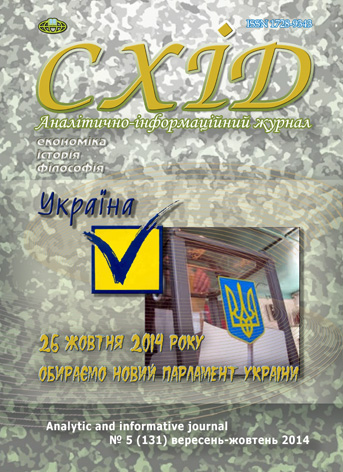Genesis, structure and forms of shadow economy in Ukraine
DOI:
https://doi.org/10.21847/1728-9343.2014.5(131).30205Keywords:
the shadow economy, the legal economy, the type of the shadow economy, the economic growthAbstract
The paper explores the development specifics of the shadow economy in Ukraine. It is indicated that reforming of the national economy in the early 1990s without any adequate scientific rationale resulted in mechanical replication and implementation of the monetary regulation model of economic processes. Realization of foreign 'recipes' for economic reforming without regard to the national specifics (lack of experience in institutional handling of and legal support to market management; avalanchine breaking of economic relations, with the USSR ruined; consequences of the systemic crisis of the USSR national economy; inherited structural deformations; the technological crisis; the obsolete technological base; the unprofitable economy; the complex environmental situation) gave rise to emergence of new forms and methods of shadow economic activity.
Downloads
References
Varnalii Z. S. (2006), Underground Economy: the nature, characteristics and ways of legalizing, National Institute for Strategic Studies, Kyiv, 576 p. (ukr).
Heiets V. M. (2004), Lessons and prospects for market reforms long-term economic growth in Ukraine, Ekonomichna teoriia [Economic Theory], № 3, pp. 3-18 (ukr).
Zhalilo Ya., Tyshchuk T. (2011), The Underground Economy in Ukraine: the magnitude and direction of overcoming, National Institute for Strategic Studies, Kyiv, 31 р. (ukr).
Zolotorev A. (1998), Efficient use of working capital, Ekonomika Ukrainy [Economy of Ukraine], № 7, рp. 12-16 (rus).
Kraus N. M. (2008), Underground and official sectors: antagonistic coexistence and interaction, Poltava, 175 p. (ukr).
Kuznetsova T. (1997), Some aspects of the study of the informal economy in Russia, Voprosy ekonomiki [Questions of economy], № 9, рp. 127-134 (rus).
Lysenko Yu., Serheieva L. (2004), Nonlinear dynamics of macroeconomic indicators, Ekonomika Ukrainy [Economy of Ukraine], № 11, рp. 27-34 (ukr).
Mazur I. I. (2006), Reducing shadow economy of Ukraine: Theory and Practice, Kyiv, 329 р. (ukr).
Naidonov V. (2003), To a question the equation of exchange and the monetary theory of inflation, Ekonomika Ukrainy [Economy of Ukraine], № 9, pp. 23-29 (ukr).
Popovych V. M. (2001), Theory of reducing shadow economy, Irpin, 524 p. (ukr).
Popovych Z. (2004), Economic growth and prospects of innovative development, Ekonomika Ukrainy [Economy of Ukraine], № 12, pp. 41-47 (ukr).
Pushkarenko P., Lohvynenko M. (2004), Genesis and socio-economic effects of the shadow economy, Ekonomika Ukrainy [Economy of Ukraine], № 10, pp. 43-49 (ukr).
Samoylenko Ye. H. (2005), On the effect of the shadow economy on the industrial and manufacturing companies, Ekonomika: problemy teorii ta praktyky [Economy: problems of the theory and practices], № 200, рp. 506-511 (rus).
Tymofeev V. (1998), The crisis of production: the main reasons, Ekonomika Ukrainy [Economy of Ukraine], № 2, рp. 20-26 (rus).
Fedorenko V. (2000), Barter economy in Ukraine, Economics, Finance, Law, № 3, pp. 10-13 (ukr).
Chechetov M., Zhadan I. (2004), Social and economic aspects of the transformation of property relations in Ukraine, Ekonomika Ukrainy [Economy of Ukraine], № 10, pp. 4-16 (ukr).
Illicit Financial Flows from Developing Countries: 2000-2009 / Global Financial Integrity Program, available at: http://www.gfip.org/storage/ gfip/documents/reports/IFF2010/gfi_iff_update_reportweb.pdf (engl).
Downloads
Published
How to Cite
Issue
Section
License
Copyright (c) 2014 Eugene Samojlenko

This work is licensed under a Creative Commons Attribution-NonCommercial-NoDerivatives 4.0 International License.
1. Authors bear responsibility for the accuracy of facts, quotations, numbers and names used.
2. Manuscripts are not sent back.
3. The publisher does not always agree with the authors' opinion.
4. The authors reserve the right to authorship of the work and pass the first publication right of this work to the journal under the terms of a Creative Commons Attribution-NonCommercial-NoDerivatives 4.0 International License. This license allows others to distribute (copy) the published work for non-commercial purposes, provided there is mandatory attribution to its authors and a link to the first publication in our journal.
5. The authors have the right to conclude separate supplement agreements that relate to non-exclusive work distribution in the form in which it has been published by the journal (for example, to upload the work to the online storage of the journal or publish it as part of a monograph), provided that the reference to the first publication of the work in this journal is included.

